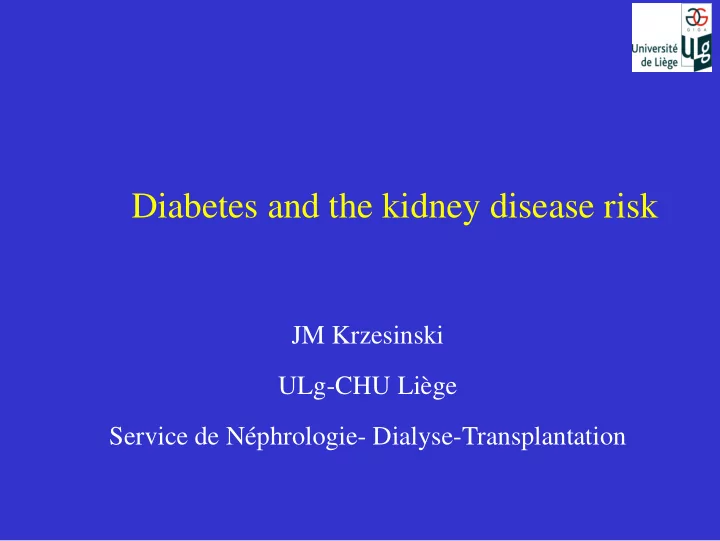

Diabetes and the kidney disease risk JM Krzesinski ULg-CHU Liège Service de Néphrologie- Dialyse-Transplantation
DIABETIC NEPHROPATHY First cause of ESRD in the XXst century
Dialysis: Incident causes of ESRD (2013) in Belgiun 23% Congénitale/Malfor Non encodée matif 3% 7% Vascular Diabetes 27% 21% Glomerulonéphrite 7% Inconnu Secondaire 6% Néphrite Tubulo- 18% interticielle 8% Pyélonéphrite 3% Causes of dialysis due to DM: in USA 40% in Asia 50%
Incident patients: Distribution according to nephropathy from 1994 - 2013 300 Diabetes mellitus 250 1994 231 1995 1996 1997 200 1998 175 1999 2000 153 150 2001 2002 2003 2004 100 2005 2006 65 60 60 2007 49 2008 50 2009 30 27 2010 2011 0 2012 2013
hyperfiltration Glomerular lesions Importance of TI lesions on the rate of progression
New paradigm of Diabetic kidney disease in the 21st century? ● In type 2 DM, kidney disease lesions could be quite different: - Association between classical DN and a mixture of different patterns (including other primary glomerular diseases)
Among 611 type 2 DM 37% 27% 36%
New paradigm of Diabetic kidney disease in the 21st century? ● In type 2 DM, kidney disease lesions could be quite different: - Association between classical DN and a mixture of different patterns (including other primary glomerular diseases) or - Presence of decreased GFR but no proteinuria.
Different patterns of DN according to GFR changes How identifying patients with slow or fast renal decline function trajectories?
Renal events (dialysis, Tx, doubling s creat) 22X higher when combining UACR >300 mg/g and eGFR <60 ml/min per 1,73m²
10% Fast decliner 68% 20% Fast decliner
Serum Concentration of Cystatin C and Risk of End-Stage Renal Disease in Diabetes Krolewski A et al. Diabetes Care 2012;35:2311-2316
Fast decliners ESRD Slow decliners
DM patients Stage 1 or 2 CKD: prediction of risk for progressive renal decline!
DM patients Stage 3 or higher CKD
Management of diabetes HbA1C according to comorbidities BP <140/85 mmHg LDL<100 Max dose mg/dl accepted If high CV risk <70
Tight glucose control (metabolic memory) Multifactorial approach
STENO2
7.5% 6.5% 8yrs saved
GLP1agonists Bariatric surgery
High CV DM risk population 63y, 72 % Males Most with history of CVE >75% with RASI and statins
Potential protective mechanisms of SGlT2 inhibition
9340 high CV risk type 2 DM, median FU 3.8y Liraglutide (GlP1 agonist) decreases the nephropathy risk, mainly in eGFR group < 60 ml/min per 1,73 m²
Mean Age 50 y; mean BMI 40; DM mean duration 3y
Conclusions ● Incidence of DM is growing and brings CV and renal risk ● An early identification of those who will be fast decliners and early multifactorial treatment approach is necessary, before development of complications. ● New treatments are urgently resquested, according to the DN development mechanisms. ● The most interesting protecting drugs come from new glucose management therapies. ● Don’t forget to apply lifestyle and diet approaches (or bariatric surgery in severe obesity).
NDT 2015 Clinical practice guidelines
NDT 2015 Clinical practice guidelines
Renal decline to ESRD ● KDIGO guidelines have defined rapid progression by a rate of eGFR decline >5 ml/min/y. ● There are indeed fast (renal function loss with an interval of 2 to less than 10y between normal function and ESRD), moderate (between 10-20y) and slow (between 20 and 45y) decline of Kidney function. ● In type 1(but also 2) DM, role of high HbA1C, urinary albumin-to-creatinine ratio values, and eGFR (cystatine C) and circulating TNF1R ● In type 2 DM, 14 biomarkers have been identified in those with stage 3 and higher CKD who will have a rapid decline of GFR .
Strict control of glycemia and protection ● Positive results for microvascular complications ● It postpones their onsets by several years if applied early ● Less convincing results for CV protection ● The benefit on CV disease of a HbA1C < 7% rather than 8% decreases with - age, - diabetes duration and - comorbidities.
Pathophysiology of classical DN Oxydative stress Metabolic Hemodynamic − Intraglomerular pressure Chronic hyperglycemia − Endothelial dysfunction PKC β ΙΙ Vasoactive hormones Glycation end-products (Ag II, endothelins, NO) Cytokines – Growth factors (TGF β, VEGF, IGFs,…) INFLAMMATION ↑ Vascular permeability Accumulation Interstitial Of EC matrix fibrosis Albuminuria GFR
Recommend
More recommend